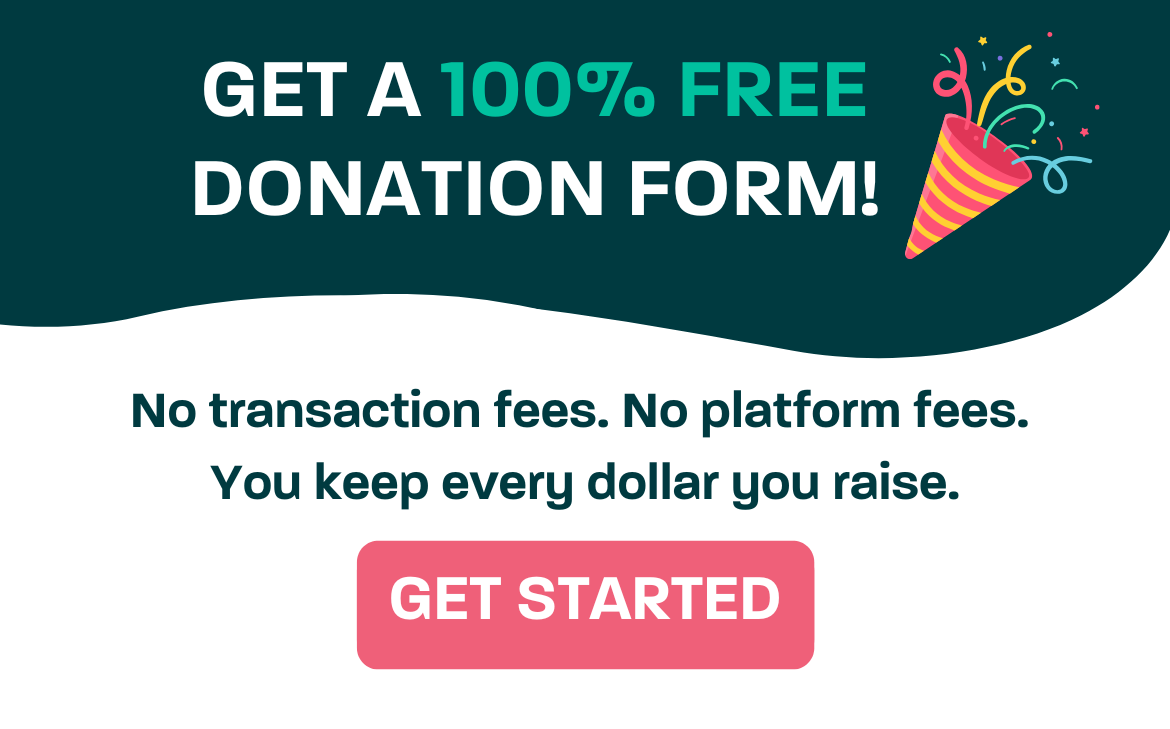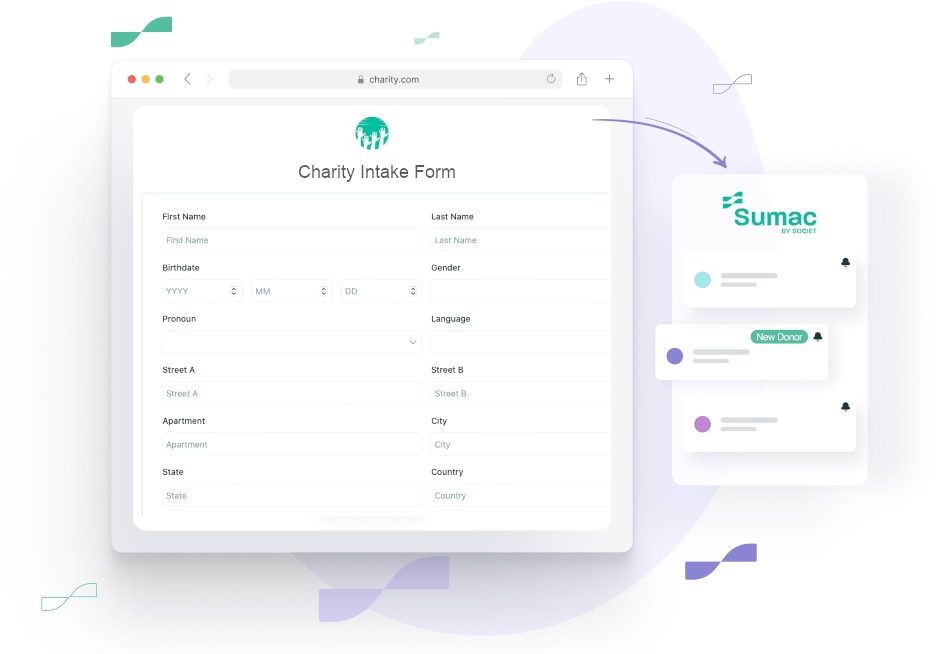Free Patient & Client Intake Form Template for Nonprofits

Patient & Client Intake Form Template
Download your free patient and client intake form template for nonprofits in Microsoft Word, PDF, Google Docs:
- General Patient Intake form for Health Services (for things like hospices, rehabilitation, mental health services, etc.)
- General Client Intake form for Social Services (for things like counselling, child & family services, social welfare, community programs, etc.)
Patient Intake Form:
Client Intake Form:
Online Patient & Client Intake Forms
Improve your client intake process with online patient & client intake forms that live on your website and integrate with your database, so you never have to import client data again.
Available with Sumac nonprofit case management software.
Benefits of Online Patient & Client Intake Forms
Efficiency and Time Savings
One of the most significant advantages of web-based intake forms is the efficiency they bring to the intake process. Traditional paper forms are not only cumbersome but also time-consuming to fill out and process.
By contrast, web-based forms allow patients and clients to enter their information directly online. This data is then automatically uploaded to your database, reducing the need for manual data entry and minimizing the risk of errors.
Improved Accuracy
Accuracy is paramount when it comes to patient and client information. Errors in data entry can lead to miscommunication, improper care, and even legal issues. Web-based intake forms significantly reduce the likelihood of such errors. Since the information is entered directly by the patients or clients, there is less room for mistakes that often occur during manual data entry.
Enhanced Security
Security is a critical concern for nonprofits handling sensitive patient and client information. Web-based intake forms offer enhanced security features that are often lacking in traditional paper forms. Digital forms can be encrypted and stored in secure databases, ensuring that sensitive information is protected from unauthorized access.
Better Data Management and Reporting
Web-based intake forms simplify data management and reporting. Since all information is stored digitally, it can be easily organized, searched, and analyzed. This is particularly beneficial for nonprofits that need to track various metrics and generate reports for stakeholders, donors, and regulatory bodies.
Increased Accessibility
Another significant benefit of web-based intake forms is their accessibility. Patients and clients can fill out these forms from anywhere, at any time, using any device with internet access. This is especially important for individuals who may have mobility issues or live in remote areas.
By making your intake process more accessible, you can reach a broader audience and ensure that everyone has the opportunity to receive the care and services they need.
Get online intake forms with Sumac.
All About Patient & Client Intake Forms
Patient and client intake forms are fundamental tools in healthcare and service industries, acting as the primary means of collecting crucial information from individuals seeking services.
These forms not only streamline the initial interaction but also enhance the quality of care and service by ensuring that professionals have access to accurate and comprehensive data.
Below we explore the importance, structure, benefits, and challenges associated with patient and client intake forms.
Importance of Intake Forms
Intake forms serve as the cornerstone of patient and client management. They collect essential data such as personal information, medical history, insurance details, and consent for treatment or services.
This information is crucial for several reasons:
- Accurate Record Keeping: Intake forms ensure that all necessary information is documented accurately, which is vital for maintaining comprehensive records. This helps in tracking patient progress, facilitating continuity of care, and ensuring legal compliance.
- Efficient Service Delivery: By gathering all relevant information upfront, service providers can prepare adequately for the appointment or consultation. This reduces the time spent on administrative tasks during the interaction and allows for more focused and personalized service.
- Legal and Ethical Compliance: Intake forms often include consent sections where clients or patients acknowledge their understanding of the services to be provided, potential risks, and their rights. This is crucial for ethical and legal compliance, protecting both the provider and the client.
Structure of Intake Forms
The structure of intake forms can vary depending on the industry and specific needs of the service provider. However, common elements typically include:
- Personal Information: This section collects basic data such as name, address, phone number, email, date of birth, and emergency contact details.
- Medical History: For healthcare providers, this section is vital and includes information about past illnesses, surgeries, allergies, medications, and family medical history. This helps in diagnosing and creating a treatment plan tailored to the patient’s needs.
- Insurance Information: Details regarding the patient’s insurance provider, policy number, and coverage specifics are collected to facilitate billing and payment processes.
- Consent and Agreement: This section includes consent for treatment, acknowledgment of privacy policies, and agreement to the terms of service. It ensures that clients are informed about their rights and the scope of the services they will receive.
- Specific Needs and Preferences: This can include dietary restrictions, preferred communication methods, and any other personal preferences that can enhance the quality of service.
Benefits of Intake Forms
Improved Patient/Client Experience: By collecting information beforehand, intake forms allow providers to tailor their services to meet individual needs, improving overall satisfaction.
- Enhanced Efficiency: Intake forms streamline administrative processes, reducing the time spent on paperwork during appointments and allowing for more efficient use of time.
- Better Data Management: Digitally stored intake forms enable easy access to patient/client data, facilitating better communication and coordination among service providers.
- Risk Management: Comprehensive intake forms help in identifying potential risks early, allowing for preventive measures and informed decision-making.
Challenges and Considerations
Despite their benefits, intake forms come with challenges that need careful consideration:
- Privacy and Security: Protecting the sensitive information collected in intake forms is paramount. Providers must ensure compliance with regulations such as HIPAA (Health Insurance Portability and Accountability Act) in the U.S. to safeguard data privacy and security.
- Complexity and Accessibility: Intake forms can be lengthy and complex, which may deter some patients or clients from completing them accurately. Providers need to balance the need for comprehensive information with the ease of completion.
- Updating Information: Keeping intake forms updated is crucial, especially in healthcare settings where medical histories and medications can change frequently. Providers must establish protocols for regularly updating and verifying the information.
- Digital Divide: While digital intake forms offer convenience and efficiency, not all clients may have access to or be comfortable with using digital platforms. Providers should offer alternatives, such as paper forms or assistance with digital completion.
Conclusion
Patient and client intake forms are indispensable tools that play a critical role in the initial stages of service delivery. They enhance the quality of care and efficiency of service by ensuring that providers have access to accurate and comprehensive information.
While challenges such as privacy concerns and form complexity exist, thoughtful design and adherence to legal standards can mitigate these issues. Ultimately, well-designed intake forms contribute significantly to a positive and efficient service experience for both providers and clients.





